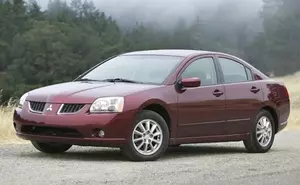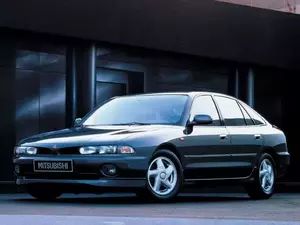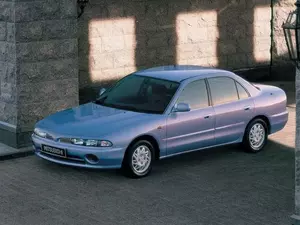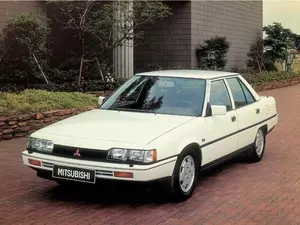
| Vehicle | Curb weight | Difference from world's smallest | Weight to power ratio | 0—60 mph acceleration ratio | Consumption ratio |
|---|---|---|---|---|---|
| 3.8 V6 |
1560 kg / 3440 lbs |
1135 kg (2503 lbs) heavier | 6 kg to 1 hp | - | - |
| 2.4 i 16V |
1560 kg / 3440 lbs |
1135 kg (2503 lbs) heavier | 10 kg to 1 hp | 143 kg/s (315 lbs/s) |
164 kg/L (362 lbs/L) |
| Vehicle | 3.8 V6 |
|---|---|
| Curb weight |
1560 kg / 3440 lbs |
| Difference from world's smallest | 1135 kg (1135 lbs) heavier |
| Weight to power ratio | 6 kg to 1 hp |
| 0—60 mph acceleration ratio | - |
| Consumption ratio | - |
| Vehicle | 2.4 i 16V |
| Curb weight |
1560 kg / 3440 lbs |
| Difference from world's smallest | 1135 kg (1135 lbs) heavier |
| Weight to power ratio | 10 kg to 1 hp |
| 0—60 mph acceleration ratio | 143 kg/s (315 lbs/s) |
| Consumption ratio |
164 kg/L (362 lbs/L) |

| Vehicle | Curb weight | Difference from world's smallest | Weight to power ratio | 0—60 mph acceleration ratio | Consumption ratio |
|---|---|---|---|---|---|
| 2.5 i V6 24V |
1480 kg / 3263 lbs |
1055 kg (2326 lbs) heavier | 9 kg to 1 hp | - | - |
| Vehicle | 2.5 i V6 24V |
|---|---|
| Curb weight |
1480 kg / 3263 lbs |
| Difference from world's smallest | 1055 kg (1055 lbs) heavier |
| Weight to power ratio | 9 kg to 1 hp |
| 0—60 mph acceleration ratio | - |
| Consumption ratio | - |

| Vehicle | Curb weight | Difference from world's smallest | Weight to power ratio | 0—60 mph acceleration ratio | Consumption ratio |
|---|---|---|---|---|---|
| 2.5 24V |
1420 kg / 3131 lbs |
995 kg (2194 lbs) heavier | 9 kg to 1 hp | 173 kg/s (381 lbs/s) |
189 kg/L (417 lbs/L) |
| 2.5 i VR-4 Type-V 4WD |
1480 kg / 3263 lbs |
1055 kg (2326 lbs) heavier | 5 kg to 1 hp | - | - |
| 2.0 GDi 16V |
1290 kg / 2844 lbs |
865 kg (1907 lbs) heavier | 9 kg to 1 hp | 140 kg/s (309 lbs/s) | - |
| 2.0 |
1260 kg / 2778 lbs |
835 kg (1841 lbs) heavier | 9 kg to 1 hp | 137 kg/s (302 lbs/s) |
148 kg/L (326 lbs/L) |
| 1.8i |
1260 kg / 2778 lbs |
835 kg (1841 lbs) heavier | 8 kg to 1 hp | 137 kg/s (302 lbs/s) | - |
| 2.4 GDI |
1320 kg / 2911 lbs |
895 kg (1974 lbs) heavier | 9 kg to 1 hp | 155 kg/s (342 lbs/s) | - |
| 2.0 TDI |
1300 kg / 2867 lbs |
875 kg (1930 lbs) heavier | 14 kg to 1 hp | - | - |
| 3.0 i V6 24V GTZ |
1520 kg / 3352 lbs |
1095 kg (2415 lbs) heavier | 8 kg to 1 hp | 177 kg/s (390 lbs/s) |
129 kg/L (284 lbs/L) |
| Vehicle | 2.5 24V |
|---|---|
| Curb weight |
1420 kg / 3131 lbs |
| Difference from world's smallest | 995 kg (995 lbs) heavier |
| Weight to power ratio | 9 kg to 1 hp |
| 0—60 mph acceleration ratio | 173 kg/s (381 lbs/s) |
| Consumption ratio |
189 kg/L (417 lbs/L) |
| Vehicle | 2.5 i VR-4 Type-V 4WD |
| Curb weight |
1480 kg / 3263 lbs |
| Difference from world's smallest | 1055 kg (1055 lbs) heavier |
| Weight to power ratio | 5 kg to 1 hp |
| 0—60 mph acceleration ratio | - |
| Consumption ratio | - |
| Vehicle | 2.0 GDi 16V |
| Curb weight |
1290 kg / 2844 lbs |
| Difference from world's smallest | 865 kg (865 lbs) heavier |
| Weight to power ratio | 9 kg to 1 hp |
| 0—60 mph acceleration ratio | 140 kg/s (309 lbs/s) |
| Consumption ratio | - |
| Vehicle | 2.0 |
| Curb weight |
1260 kg / 2778 lbs |
| Difference from world's smallest | 835 kg (835 lbs) heavier |
| Weight to power ratio | 9 kg to 1 hp |
| 0—60 mph acceleration ratio | 137 kg/s (302 lbs/s) |
| Consumption ratio |
148 kg/L (326 lbs/L) |
| Vehicle | 1.8i |
| Curb weight |
1260 kg / 2778 lbs |
| Difference from world's smallest | 835 kg (835 lbs) heavier |
| Weight to power ratio | 8 kg to 1 hp |
| 0—60 mph acceleration ratio | 137 kg/s (302 lbs/s) |
| Consumption ratio | - |
| Vehicle | 2.4 GDI |
| Curb weight |
1320 kg / 2911 lbs |
| Difference from world's smallest | 895 kg (895 lbs) heavier |
| Weight to power ratio | 9 kg to 1 hp |
| 0—60 mph acceleration ratio | 155 kg/s (342 lbs/s) |
| Consumption ratio | - |
| Vehicle | 2.0 TDI |
| Curb weight |
1300 kg / 2867 lbs |
| Difference from world's smallest | 875 kg (875 lbs) heavier |
| Weight to power ratio | 14 kg to 1 hp |
| 0—60 mph acceleration ratio | - |
| Consumption ratio | - |
| Vehicle | 3.0 i V6 24V GTZ |
| Curb weight |
1520 kg / 3352 lbs |
| Difference from world's smallest | 1095 kg (1095 lbs) heavier |
| Weight to power ratio | 8 kg to 1 hp |
| 0—60 mph acceleration ratio | 177 kg/s (390 lbs/s) |
| Consumption ratio |
129 kg/L (284 lbs/L) |

| Vehicle | Curb weight | Difference from world's smallest | Weight to power ratio | 0—60 mph acceleration ratio | Consumption ratio |
|---|---|---|---|---|---|
| 2.0 TDI |
1350 kg / 2977 lbs |
925 kg (2040 lbs) heavier | 15 kg to 1 hp | - | - |
| 2.0 |
1310 kg / 2889 lbs |
885 kg (1952 lbs) heavier | 10 kg to 1 hp | 138 kg/s (304 lbs/s) | - |
| 2.4 GDI |
1370 kg / 3021 lbs |
945 kg (2084 lbs) heavier | 9 kg to 1 hp | 157 kg/s (346 lbs/s) | - |
| 2.5 24V |
1340 kg / 2955 lbs |
915 kg (2018 lbs) heavier | 8 kg to 1 hp | 172 kg/s (379 lbs/s) | - |
| 2.4 GDi 16V |
1340 kg / 2955 lbs |
915 kg (2018 lbs) heavier | 9 kg to 1 hp | - | - |
| Vehicle | 2.0 TDI |
|---|---|
| Curb weight |
1350 kg / 2977 lbs |
| Difference from world's smallest | 925 kg (925 lbs) heavier |
| Weight to power ratio | 15 kg to 1 hp |
| 0—60 mph acceleration ratio | - |
| Consumption ratio | - |
| Vehicle | 2.0 |
| Curb weight |
1310 kg / 2889 lbs |
| Difference from world's smallest | 885 kg (885 lbs) heavier |
| Weight to power ratio | 10 kg to 1 hp |
| 0—60 mph acceleration ratio | 138 kg/s (304 lbs/s) |
| Consumption ratio | - |
| Vehicle | 2.4 GDI |
| Curb weight |
1370 kg / 3021 lbs |
| Difference from world's smallest | 945 kg (945 lbs) heavier |
| Weight to power ratio | 9 kg to 1 hp |
| 0—60 mph acceleration ratio | 157 kg/s (346 lbs/s) |
| Consumption ratio | - |
| Vehicle | 2.5 24V |
| Curb weight |
1340 kg / 2955 lbs |
| Difference from world's smallest | 915 kg (915 lbs) heavier |
| Weight to power ratio | 8 kg to 1 hp |
| 0—60 mph acceleration ratio | 172 kg/s (379 lbs/s) |
| Consumption ratio | - |
| Vehicle | 2.4 GDi 16V |
| Curb weight |
1340 kg / 2955 lbs |
| Difference from world's smallest | 915 kg (915 lbs) heavier |
| Weight to power ratio | 9 kg to 1 hp |
| 0—60 mph acceleration ratio | - |
| Consumption ratio | - |

| Vehicle | Curb weight | Difference from world's smallest | Weight to power ratio | 0—60 mph acceleration ratio | Consumption ratio |
|---|---|---|---|---|---|
| 2.0 V6-24 |
1378 kg / 3038 lbs |
953 kg (2101 lbs) heavier | 9 kg to 1 hp | 160 kg/s (353 lbs/s) |
155 kg/L (342 lbs/L) |
| 2.0 GLSI |
1331 kg / 2935 lbs |
906 kg (1998 lbs) heavier | 10 kg to 1 hp | 143 kg/s (315 lbs/s) |
160 kg/L (353 lbs/L) |
| 1.8 |
1261 kg / 2781 lbs |
836 kg (1844 lbs) heavier | 11 kg to 1 hp | 131 kg/s (289 lbs/s) |
168 kg/L (370 lbs/L) |
| 2.0 GLSTD |
1346 kg / 2968 lbs |
921 kg (2031 lbs) heavier | 15 kg to 1 hp | 100 kg/s (221 lbs/s) |
198 kg/L (437 lbs/L) |
| 2.5 V6-24 4x4 |
1545 kg / 3407 lbs |
1120 kg (2470 lbs) heavier | 9 kg to 1 hp | 182 kg/s (401 lbs/s) |
147 kg/L (324 lbs/L) |
| Vehicle | 2.0 V6-24 |
|---|---|
| Curb weight |
1378 kg / 3038 lbs |
| Difference from world's smallest | 953 kg (953 lbs) heavier |
| Weight to power ratio | 9 kg to 1 hp |
| 0—60 mph acceleration ratio | 160 kg/s (353 lbs/s) |
| Consumption ratio |
155 kg/L (342 lbs/L) |
| Vehicle | 2.0 GLSI |
| Curb weight |
1331 kg / 2935 lbs |
| Difference from world's smallest | 906 kg (906 lbs) heavier |
| Weight to power ratio | 10 kg to 1 hp |
| 0—60 mph acceleration ratio | 143 kg/s (315 lbs/s) |
| Consumption ratio |
160 kg/L (353 lbs/L) |
| Vehicle | 1.8 |
| Curb weight |
1261 kg / 2781 lbs |
| Difference from world's smallest | 836 kg (836 lbs) heavier |
| Weight to power ratio | 11 kg to 1 hp |
| 0—60 mph acceleration ratio | 131 kg/s (289 lbs/s) |
| Consumption ratio |
168 kg/L (370 lbs/L) |
| Vehicle | 2.0 GLSTD |
| Curb weight |
1346 kg / 2968 lbs |
| Difference from world's smallest | 921 kg (921 lbs) heavier |
| Weight to power ratio | 15 kg to 1 hp |
| 0—60 mph acceleration ratio | 100 kg/s (221 lbs/s) |
| Consumption ratio |
198 kg/L (437 lbs/L) |
| Vehicle | 2.5 V6-24 4x4 |
| Curb weight |
1545 kg / 3407 lbs |
| Difference from world's smallest | 1120 kg (1120 lbs) heavier |
| Weight to power ratio | 9 kg to 1 hp |
| 0—60 mph acceleration ratio | 182 kg/s (401 lbs/s) |
| Consumption ratio |
147 kg/L (324 lbs/L) |

| Vehicle | Curb weight | Difference from world's smallest | Weight to power ratio | 0—60 mph acceleration ratio | Consumption ratio |
|---|---|---|---|---|---|
| 2.0 V6-24 |
1338 kg / 2950 lbs |
913 kg (2013 lbs) heavier | 9 kg to 1 hp | 156 kg/s (344 lbs/s) |
150 kg/L (331 lbs/L) |
| 2.0 GLSI 4x4 |
1130 kg / 2492 lbs |
705 kg (1555 lbs) heavier | 8 kg to 1 hp | 123 kg/s (271 lbs/s) | - |
| 2.0 GLSI |
1291 kg / 2847 lbs |
866 kg (1910 lbs) heavier | 9 kg to 1 hp | 140 kg/s (309 lbs/s) |
156 kg/L (344 lbs/L) |
| 1.8 |
1231 kg / 2714 lbs |
806 kg (1777 lbs) heavier | 11 kg to 1 hp | 130 kg/s (287 lbs/s) |
164 kg/L (362 lbs/L) |
| 1.8 i |
1200 kg / 2646 lbs |
775 kg (1709 lbs) heavier | 9 kg to 1 hp | 140 kg/s (309 lbs/s) | - |
| 2.0 24 V V6 T |
1430 kg / 3153 lbs |
1005 kg (2216 lbs) heavier | 6 kg to 1 hp | - | - |
| 2.0 GLSTD |
1306 kg / 2880 lbs |
881 kg (1943 lbs) heavier | 15 kg to 1 hp | 99 kg/s (218 lbs/s) |
192 kg/L (423 lbs/L) |
| 2.5 V6-24 4x4 |
1505 kg / 3319 lbs |
1080 kg (2382 lbs) heavier | 9 kg to 1 hp | 179 kg/s (395 lbs/s) |
143 kg/L (315 lbs/L) |
| Vehicle | 2.0 V6-24 |
|---|---|
| Curb weight |
1338 kg / 2950 lbs |
| Difference from world's smallest | 913 kg (913 lbs) heavier |
| Weight to power ratio | 9 kg to 1 hp |
| 0—60 mph acceleration ratio | 156 kg/s (344 lbs/s) |
| Consumption ratio |
150 kg/L (331 lbs/L) |
| Vehicle | 2.0 GLSI 4x4 |
| Curb weight |
1130 kg / 2492 lbs |
| Difference from world's smallest | 705 kg (705 lbs) heavier |
| Weight to power ratio | 8 kg to 1 hp |
| 0—60 mph acceleration ratio | 123 kg/s (271 lbs/s) |
| Consumption ratio | - |
| Vehicle | 2.0 GLSI |
| Curb weight |
1291 kg / 2847 lbs |
| Difference from world's smallest | 866 kg (866 lbs) heavier |
| Weight to power ratio | 9 kg to 1 hp |
| 0—60 mph acceleration ratio | 140 kg/s (309 lbs/s) |
| Consumption ratio |
156 kg/L (344 lbs/L) |
| Vehicle | 1.8 |
| Curb weight |
1231 kg / 2714 lbs |
| Difference from world's smallest | 806 kg (806 lbs) heavier |
| Weight to power ratio | 11 kg to 1 hp |
| 0—60 mph acceleration ratio | 130 kg/s (287 lbs/s) |
| Consumption ratio |
164 kg/L (362 lbs/L) |
| Vehicle | 1.8 i |
| Curb weight |
1200 kg / 2646 lbs |
| Difference from world's smallest | 775 kg (775 lbs) heavier |
| Weight to power ratio | 9 kg to 1 hp |
| 0—60 mph acceleration ratio | 140 kg/s (309 lbs/s) |
| Consumption ratio | - |
| Vehicle | 2.0 24 V V6 T |
| Curb weight |
1430 kg / 3153 lbs |
| Difference from world's smallest | 1005 kg (1005 lbs) heavier |
| Weight to power ratio | 6 kg to 1 hp |
| 0—60 mph acceleration ratio | - |
| Consumption ratio | - |
| Vehicle | 2.0 GLSTD |
| Curb weight |
1306 kg / 2880 lbs |
| Difference from world's smallest | 881 kg (881 lbs) heavier |
| Weight to power ratio | 15 kg to 1 hp |
| 0—60 mph acceleration ratio | 99 kg/s (218 lbs/s) |
| Consumption ratio |
192 kg/L (423 lbs/L) |
| Vehicle | 2.5 V6-24 4x4 |
| Curb weight |
1505 kg / 3319 lbs |
| Difference from world's smallest | 1080 kg (1080 lbs) heavier |
| Weight to power ratio | 9 kg to 1 hp |
| 0—60 mph acceleration ratio | 179 kg/s (395 lbs/s) |
| Consumption ratio |
143 kg/L (315 lbs/L) |

| Vehicle | Curb weight | Difference from world's smallest | Weight to power ratio | 0—60 mph acceleration ratio | Consumption ratio |
|---|---|---|---|---|---|
| 2.0 GTI 16V 4x4 |
1341 kg / 2957 lbs |
916 kg (2020 lbs) heavier | 9 kg to 1 hp | - | - |
| Vehicle | 2.0 GTI 16V 4x4 |
|---|---|
| Curb weight |
1341 kg / 2957 lbs |
| Difference from world's smallest | 916 kg (916 lbs) heavier |
| Weight to power ratio | 9 kg to 1 hp |
| 0—60 mph acceleration ratio | - |
| Consumption ratio | - |

| Vehicle | Curb weight | Difference from world's smallest | Weight to power ratio | 0—60 mph acceleration ratio | Consumption ratio |
|---|---|---|---|---|---|
| 1.6 GLX |
1065 kg / 2348 lbs |
640 kg (1411 lbs) heavier | 14 kg to 1 hp | 89 kg/s (196 lbs/s) |
142 kg/L (313 lbs/L) |
| Vehicle | 1.6 GLX |
|---|---|
| Curb weight |
1065 kg / 2348 lbs |
| Difference from world's smallest | 640 kg (640 lbs) heavier |
| Weight to power ratio | 14 kg to 1 hp |
| 0—60 mph acceleration ratio | 89 kg/s (196 lbs/s) |
| Consumption ratio |
142 kg/L (313 lbs/L) |